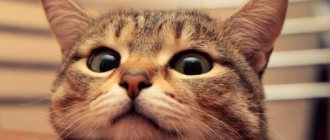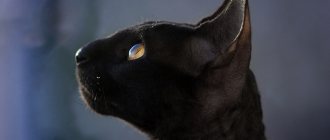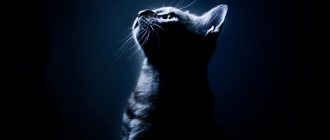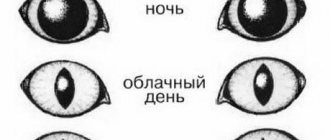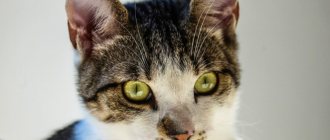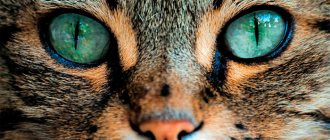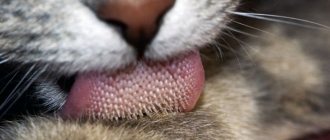Everyone knows that cats have acute vision. Predators need it to hunt, and prey needs it to hide in time. What do we mean when we say “excellent vision”? We mean the ability to distinguish the slightest shades of the color spectrum, to clearly see objects near and far. Can these visual abilities be applied to animals, particularly cats? Or do house purrs see the world not so clear and bright, or maybe they think it is black and white? Today we will tell you interesting facts about how cats see, as well as how dogs see, and how animal vision differs from ours.
- 3 A faded world, but wide
- 4 Some more interesting facts
How snakes, dogs and other animals see: a scientific experiment.
Have you ever wondered how animals see the world around them? If yes, then Home Advisor will help you answer this question, whose specialists have conducted an entire scientific study on this topic.
Home Advisor created a digital room and placed animals around it. They then visualized the images based on how a particular animal would see them. For example, dogs see very few colors, and spiders see so blurry that you might think they need glasses.
So if you have ever wondered how a little goldfish sees the world from its aquarium or how a chameleon uses its eyes, then this post will be of interest to you. Well, tell me, isn’t it interesting to be “in the shoes” of a dog, parrot or snake, even if not literally, but virtually? Personally, we found this Home Advisor idea tempting.
Cows
Many believe, and we are often told, that domestic artiodactyls react strongly to the color red. In reality, the eyes of these animals perceive the color palette in very blurry, fuzzy tones. That's why bulls and cows respond more to movement than to how your clothes are colored or what color is waved in front of their face. I wonder, who will like it if they start waving some kind of rag in front of his nose, sticking spears into the back of his neck?
And yet, how do animals see? Cows, judging by the structure of their eyes, are able to distinguish all colors: white and black, yellow and green, red and orange. But only weakly and blurry. Interestingly, cows have vision like a magnifying glass, and it is for this reason that they are often scared when they see people unexpectedly approaching them.
This is how animals see the room: dog
The original image of how a person sees the room:
homeadvisor
Your dog perceives almost any style that you create at home in pastel colors. Dogs see muted combinations of colors filtered through their two-cone eyes: blue and yellow.
An image that shows how a dog sees the room:
homeadvisor
How blind are bats?
According to the prevailing stereotype, bats are blind, which, however, is actually far from the truth. Fruit bats, also known as flying foxes, have both cones and rods, giving them color and day vision.
However, some species of bats still rely on echolocation, emitting ultrasound to “sense” the presence of prey and “see” in the night.
animals, vision, cognitive
How does a cat see?
Original image of how a person sees the room:
homeadvisor
Cats must see things differently in order to live the way they do. But if we put aside the existential component, it is worth noting that cats have excellent night vision. While humans have many cones in their retinas, cats have many rods, a different type of photoreceptor cell that is sensitive to low light.
An image that shows how a cat sees the room:
homeadvisor
Your cat has a wider field of view than you (200 degrees versus 180), but not as wide as a dog. A cat's color vision falls somewhere in between yours and your dog's, as it is a dichromate (has two color cones) that sees blue and yellow with a little green as a bonus.
Are all mice gray in the dark?
It is a known fact that cats see six times better than humans. Since the cat is a predator that prefers to hunt at night, nature took care of the perfection of its “night vision device.” The animal easily focuses its sharp gaze at any distance and is able to see all the smallest details of a small mouse in the deep twilight in thick grass. But contrary to popular belief, a cat cannot distinguish objects in pitch darkness. Her eyes need some source of light, at least a hint of it. Once on the retina, the light spot is duplicated many times, illuminating everything around.
If you close a person and a cat in a completely dark room, the animal, although it will not see anything around it, will still begin to move more confidently. She has an assistant and guide - sensitive vibrissae (whiskers). By spreading them and touching objects with them, the cat receives information about the surrounding space.
The pupil of cats is designed completely differently from that of us humans. It is positioned vertically and has the remarkable ability to transform from a narrow slit into huge circles, filling the entire iris. Nature has taken good care of protecting the furry predator’s retina: in bright light, the pupils are completely constricted so that the rays do not damage their fine structure. In the dark, the pupils turn into black circles, absorbing the slightest source of light.
Have you ever seen a cat in the dark when the light falls on its face? The eyes become like spotlights, they burn with some unearthly fire, like the eyes of the “hound of Baskerville,” which is clearly visible in the photo taken at night. Cats' eyes don't actually glow, they just reflect the color that falls on them. What makes your eyes turn into spotlights? On the back wall of the cat's eye there is a so-called speculum - a layer of cells (tapetum). It intercepts the incident light and returns it back to the retina.
How does a goldfish see?
Original image of how a person sees the room:
homeadvisor
Your goldfish can see more colors than you. Her ability to sense ultraviolet light helps her not only see in the water, but also notice where your dog was trying to mark his territory on the couch.
An image that shows how a fish sees the room:
homeadvisor
Accordingly, goldfish eyes have the effect of a fisheye lens. Its round corneas collect light from the surface nearly 360 degrees and are about the same density as water, which compensates for the distorting effects of light in water.
Reptiles
While talking about how animals see, one cannot remain silent about how snakes see. The fairy tale about Mowgli, where a boa constrictor bewitches the monkeys with his gaze, leaves you in awe. But is this true? Let's figure it out.
Snakes have very poor vision, which is affected by the protective membrane covering the reptile's eye. This makes the named organs appear cloudy and take on that terrifying appearance about which legends are made. But vision is not the main thing for snakes; they mainly attack moving objects. That's why the fairy tale says that the monkeys sat in a daze - they instinctively knew how to escape.
Not all snakes have unique thermal sensors, but they still distinguish infrared radiation and colors. The snake has binocular vision, which means it sees two pictures. And the brain, quickly processing the information received, gives it an idea of the size, distance and outline of the potential victim.
How does a snake see
Original image of how a person sees the room:
homeadvisor
If your only pet is a snake, you don't need to worry about the visual design of your interior. Most snakes have very poor vision in daylight, while they see much better at night.
An image that shows how the snake sees the room:
homeadvisor
A bonus for some species of snakes is infrared vision. Your snake can combine thermal data from its internal organs (the thin membranes between its eyes and nostrils) with visual data to create a thermal-like image.
"50 shades of grey"
Yes, the subtitle contains the name of a fashionable film, but the article is about cats! So, the eyes of this cute creature are capable of distinguishing, of course, not 50, but 25 shades of gray. This is necessary so that, again, in the twilight, you can clearly see the prey: its size and color. The photo below shows a city at night: above is what a person sees, below is a cat. It turns out that only a small part of the picture is accessible to our eyes, while the domestic purr is able to see even small details.
How does a spider see?
Original image of how a person sees the room:
homeadvisor
Most spiders have eight rather weak eyes and rely more on their hairy legs to navigate.
An image that shows how a spider sees a room:
homeadvisor
However, researchers have recently discovered that the color-sensitive structures of opsins (a type of protein) can make them sensitive to color and used to find mates.
So if you notice your spider frolicking with a bright blue ashtray, then science is right.
Giraffes: communication and safety
Giraffes use their height and keen vision to spot predators and warn other animals of impending danger. Also, their ability to see colors and a large field of vision helps them keep track of other giraffes.
With the help of their vision, giraffes can communicate using a special gaze system. For example, a stare warns others of impending danger, another can be used to tell other giraffes to stay away.
How does a parrot see?
Original image of how a person sees the room:
homeadvisor
Birds rely heavily on a highly efficient visual system, and your parrot can see the ultraviolet, blue, green and red color ranges. In fact, the "purple" color in this picture was used to double the ultraviolet radiation, which is actually colorless and invisible to humans.
An image that shows how a parrot sees a room:
homeadvisor
Parrots can also adjust focus very quickly and have nearly 300-degree coverage, but their vision is monocular, meaning one eye focuses on one thing while the other wanders. In addition, they can constrict their pupils at will.
Birds
Birds are amazing in their diversity of species. It is interesting that the vision of this category of living beings also varies greatly. It all depends on what kind of life the bird leads.
So, everyone knows that predators have extremely acute vision. Some species of eagles can spot their prey from a height of more than a kilometer and drop like a stone to catch it. Did you know that certain species of birds of prey are able to see ultraviolet light, which allows them to find the nearest field mouse burrows in the dark?
The magnificent owl cannot move its eyes, but it is endowed with a very flexible neck that allows it to turn its head 180 degrees. Surprisingly, this predator does not see well in the dark and usually catches prey using its hearing.
And the budgie living in your home has excellent eyesight and is able to see everything in color. Studies have proven that these individuals distinguish each other using bright plumage.
Of course, this topic is very broad, but we hope that the facts presented will be useful to you in understanding how animals see.
How does a chameleon see?
Original image of how a person sees the room:
homeadvisor
The house chameleon not only absorbs, converts and re-emit color (changes color to regulate temperature and communicate); his eyes contain predominantly cones rather than rods, so he sees many colors (including the ultraviolet spectrum) but has difficulty seeing contrast.
An image that shows how a chameleon sees a room:
homeadvisor
Your chameleon's field of view is 342 degrees. If you need to sneak up on him, you'll find that he has an 18-degree blind spot behind his head.
Can't tell the back of the head from the face
Another recent experiment involved dogs recognizing human faces. It is logical to assume that in the process of domestication, which lasted thousands of years, and living alongside Homo sapiens, dogs should have learned to distinguish human faces better than other types of domestic animals.
Scientists from the University of Budapest, together with Mexican colleagues, conducted MRI scans of the brains of dogs while they were shown videos depicting the faces and backs of other dogs, as well as the faces and backs of strangers. The experiment revealed that the visual cortex of a dog's brain is unable to distinguish the back of its head from its face! All that the tailed subjects were able to demonstrate was the ability to separate images of their relatives from images of people.
Article on the topic
Smell for the virus. Service dogs are being trained to detect COVID-19 by smell
The researchers concluded that there is no special region in the brains of these animals that would be responsible for recognizing faces (and dog faces), and this, of course, seems strange. Moreover, earlier neurophysiologists conducted another study and seemed to have found such an area of the brain: it is located in the same place as in all higher primates. The dogs were shown photographs and videos of people's faces and foreign objects. All of them showed a significant increase in activity in the areas of the temporal lobes. Moreover, it was found that this ability is innate, and not the result of training.
However, scientists have concluded that dogs cannot look at two-dimensional images for long. They need the picture to be three-dimensional. There is another observation (perhaps it explains why animals could not distinguish the back of the head from the face when watching videos): the frequency at which the dog’s eye perceives the alternation of frames as a moving image is slightly higher than that of a person (80 hertz versus 50-60) . Therefore, say, on your home TV screen your pet sees not a movie, but incoherently flashing pictures.
No salt and no variety. What food does your pet need? More details
Cat's eyes
The fact is that the cat's eyes are actually huge. Proportional, of course. Look at the cat's eyes - and at the cat itself! Here even anime cartoon characters rest nervously... And these eyes are bulging, and this provides a good overview - two hundred and seventy degrees. The shape of the pupil changes - this is influenced by the strength of the light stream, and the width of the pupil reflects the cat's feelings. And finally, the third eyelid! This is a protective barrier against damage and dust; it can be seen if the cat's eyes are half-closed.
Why do we see colors?
The concept of color is quite individual.
No one can be sure that they see color exactly the same as others. For example, Homer called the sea wine-red, and some ancient Greek authors spoke of the green color of the human face. In fact, not a single object has color, but only absorbs white daylight, while reflecting only one part of it - a certain part of the solar spectrum. The leaves on the trees absorb all parts of the solar spectrum except for the green part, which they reflect. That's why it's green in our eyes.
A person is able to see colors thanks to the peculiarities of the optical apparatus. Three light-sensitive “wires” lead from the retina to the brain Each of them is responsible for the perception of one of the primary colors: red, green or blue. The absence of at least one such “wire” causes color blindness. And even a slight deviation causes a different color assessment.
Unfortunately, animals cannot tell us whether they see colors. However, scientists believe that many of them do not have those very “wires” that provide a rosy perception of the world.
